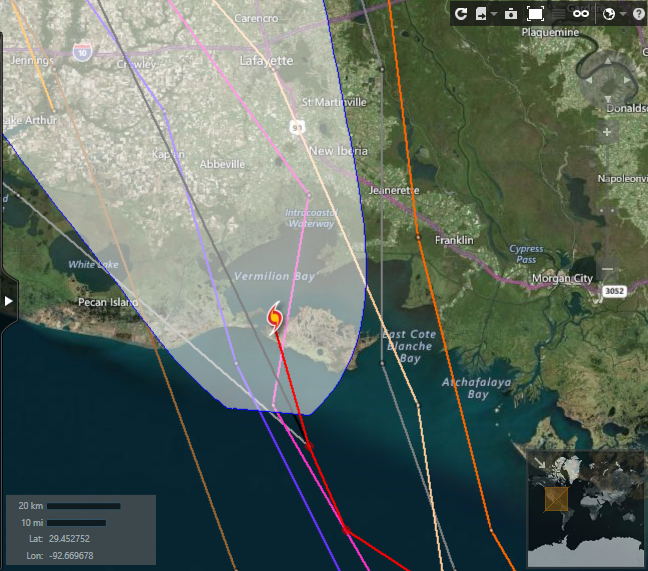Meteorologist Ryan Maue tweeted earlier this morning that Tropical Storm Barry could make landfall in the next couple hours as a hurricane. The storm is expected to dump as much as 25 inches of rain and trigger dangerous storm surges along the Gulf of Mexico, expected to make landfall in Vermilion Bay, located in southwestern Iberia Parish and southeastern Vermilion Parish.
As of 11 am ET, the National Hurrican Center (NHC) published new data that indicated Barry had become a Category 1 hurricane, with sustained winds of 75 mph, as it moves onto the Lousiana Coast.
Thousands have already lost power across the coastal Louisiana region. As of 5 am ET, as many as 62,305 Louisianans are without power, according to local electric providers in the state.
After landfall, weather models show the storm could move north to Arkansas with a hook-right to the Rust Belt next week.
As Barry makes landfall across Vermilion Bay, the system is moving at 5 mph, could cause “significant flooding” in the impact region, reported the National Weather Service (NWS).
President Trump declared a federal emergency for Louisiana on Thursday, allowing the Department of Homeland Security (DHS) and Federal Emergency Management Agency (FEMA) to coordinate all disaster relief missions.
LATEST: Louisiana Gov. Edwards says Tropical Storm Barry will make landfall Saturday morning “as a hurricane,” and says Pres. Trump approved request for pre-landfall federal disaster declaration. https://t.co/RQZ1C8blWS pic.twitter.com/PsDnO5yqMu
— ABC News (@ABC) July 12, 2019
NHC forecasts were right; the storm has indeed strengthened into a hurricane, expected to dump 25 inches of rain in parts of the state that could contribute to severe flooding.
The NHC warned that extreme rain would flood the coastal regions south of Baton Rouge and New Orleans.
“It’s powerful. It’s strengthening. And water is going to be a big issue,” National Hurricane Center Director Ken Graham said ahead of the storm.
This could impact operations at regional refineries.
Phillips 66 Friday completed the “orderly shutdown” of its 294,700 b/d Alliance refinery in Belle Chasse, Louisiana, because of the mandatory evacuation of Plaquemines Parish. While crude and feedstock processing has ceased at the plant, Phillips 66 said utilities at the facility “remain active for restart facilities to begin as soon as it is safe to do so.”
Shipping disruptions across the Lower Mississippi River are expected. The Port of South Louisiana’s Marine Operations Department has declared “Condition Zulu,” meaning “no movement is authorized on the Lower Mississippi River from MM 20 BHP to MM 303 AHP without permission from the COTP or designated representative.”
A spokeswoman for the Louisiana Department of Environmental Quality said the Stolthaven terminal in New Orleans had shut down.
Farmers in the state could see their newly planted fields flooded. Heavy winds could damage sugar mills in the region and other agriculture infrastructure, reported Bloomberg. Meanwhile, the seafood industry in the Gulf of Mexico has shut down, and agribusiness Cargill Inc. has halted grain-loading operations.
“It’s an emotional drain, to say the least,” said fifth-generation Louisiana farmer George LaCour, who raises cotton, sugarcane, corn, wheat, rice and crawfish on 10,000 acres, some of which are in the Morganza Spillway.
Barry could be another disaster for America’s agricultural economy this year, already dealing with the hardships of record rains in the Midwest and a collapse in exports to China thanks to the trade war. Some have equated the 2019 farm crisis to the crisis of the early 1980s.
Watch a live hurricane feed from WML-TV
via ZeroHedge News https://ift.tt/2jITTEp Tyler Durden





